Widgetized Section
Go to Admin » Appearance » Widgets » and move Gabfire Widget: Social into that MastheadOverlay zone
USPSA Handgun Nationals – Getting To Know Your Medalists – Julie Golob, 2nd Place Production
Courtesy of our friends at the Women of USPSA blog.
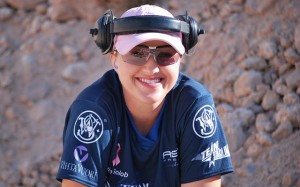 WoUSPSA: Julie – congratulations on your silver-medal finish at the Production Nationals! What did you think of the stages at this year’s Limited / Production Nationals and did you have a favorite?
WoUSPSA: Julie – congratulations on your silver-medal finish at the Production Nationals! What did you think of the stages at this year’s Limited / Production Nationals and did you have a favorite?
Julie: I thought this year’s nationals was much better than last year. It was very challenging and you had to be on the top of your game for every single stage.
As for a favorite, it had to be Stage 5, Aces All Around – Part Deuce. The RO staff on that stage was having a GREAT time and it showed in how they presented and ran the course. It was also a stage that was straight forward but still tested a number of skills, like how fast you could set up into a position. There were a number of areas where you had to switch gears between easy open targets and tough shots. Added to all that was the opportunity to shoot on the move if you were feeling adventurous. Excellent design, awesome crew!
WoUSPSA: The walk-through was definitely entertaining! : ) What do you think of the range/match location and the back-to-back format?
Julie: I think Vegas makes a lot of sense for a nationals location. There are many things to do during down time, good food options and it is a city that is easily accessible to most. It’s a logical choice. That said, I can say I wasn’t exactly thrilled about the fact that there were so many ricochets. I was on edge about it every time I stepped on the range.
WoUSPSA: You had a crazy schedule prior to the USPSA Nationals! Upon returning from the IDPA Nationals late September, you left for Australia to shoot the WAPC and returned from downunder on the 10th. Do you have any misgivings about attending all three major events, essentially back-to-back, and how many hours did Oct/10/2010 actually last for you : )
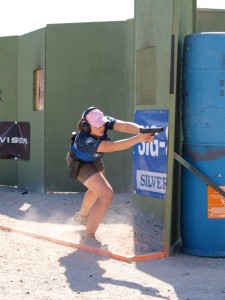 Julie: It was beyond crazy. What was I thinking??? I do think it’s pretty cool that my 10/10/10 was something like 38 hours. Not many can say they traveled back in time like that, especially on that day! ; ) Earlier in the year when I made my schedule, I even considered flying straight to Vegas from Australia to shoot through the L-10 match on the last 2 days. I am SO glad I didn’t even attempt that!
Julie: It was beyond crazy. What was I thinking??? I do think it’s pretty cool that my 10/10/10 was something like 38 hours. Not many can say they traveled back in time like that, especially on that day! ; ) Earlier in the year when I made my schedule, I even considered flying straight to Vegas from Australia to shoot through the L-10 match on the last 2 days. I am SO glad I didn’t even attempt that!
I knew it was going to be tough but really, they were all CAN’T MISS events for me. I wanted the chance to win back the ladies title at the IDPA Nationals. I just couldn’t pass up the chance to represent Team USA and see Australia. To miss out on the USPSA Nationals wasn’t an option either. I wish I had more time to prepare for all three, but I was able to learn so much from the whirlwind experience.
WoUSPSA: Well, we’re very proud of your trio of performances! Though you shot the M&P at two of the three previously-mentioned events, the courses of fire, approach and methodology of the three matches are completely different. How do you change gears and adapt to radically different disciplines so quickly?
Julie: I have competed in so many different events this year, so it is critical that I stay organized. I keep my gear and ammo set up so I can literally grab and go. I also try to find common ground between all the divisions. For example, I like to set up my holster and magazines as close to the same place as possible for all my rigs. It just makes the transition easier. When it comes to the shooting part, the common factors of sight alignment and trigger control are about the same. The differences lie in acceptable sight pictures, speed and specific skills for the sport/division that are sometimes wildly different. For each competition, I have to remind myself to trust my shooting ability and make sure I plan to tackle those sport specific skills for every single stage.
WoUSPSA: When did you start training for the Nationals, and how much was range time compared to dry firing?
Julie: I started training for the USPSA Nationals right after Steel Challenge in August. At the time I had planned to shoot revolver so I spent many hours dry firing. With the ammunition situation still unsettled, other than 250 or so rounds, my training was focused solely on dry fire. The beauty of revolver is that because of the double action I could actually run through courses of fire pulling the trigger for every shot and working my reloads even without ammo. Because you can do so much without actually shooting, revolver a great division for those on a budget.
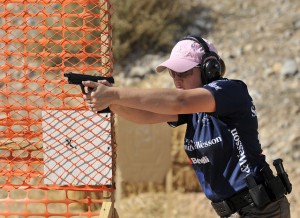 WoUSPSA: Your well-organized system undoubtedly works great for you! When you arrived in Vegas, you had a big decision to make: Shoot Revolver Division in an attempt to acquire a National Title in the last of six divisions, which is something no other competitive shooter has attained; or shoot Production, with which you’re much more familiar, confident and established. What were the ultimate deciding factors?
WoUSPSA: Your well-organized system undoubtedly works great for you! When you arrived in Vegas, you had a big decision to make: Shoot Revolver Division in an attempt to acquire a National Title in the last of six divisions, which is something no other competitive shooter has attained; or shoot Production, with which you’re much more familiar, confident and established. What were the ultimate deciding factors?
Julie: I REALLY wanted to shoot revolver this year. I put a lot of time into dry firing and speeding up my reload. To win the 6th Division Title would have been incredible, but also a huge challenge. Annette Aysen hasn’t lost a USPSA revolver ladies title since she returned to the circuit years ago. Talk about an undefeated streak! I have so much respect for her. With the revolver though, it was one struggle after another to get a load to both function and shoot well between juggling all the different matches this season.
I literally packed both sets of gear, revolvers and my S&W M&P, when I left for the match. On registration day I was at the zero range with a chrono testing yet more ammo that my awesome buddy Seiichi Ishikawa loaded for me. It was just 20 feet per second under major. So for me, shooting barely minor in a match with very little A-zone exposure, didn’t make sense. I knew Annette would shoot strong to post a win for Team Smith & Wesson. Winning Production would be a long shot considering my preparation compared to my competition, but I decided to try for a Top 3 finish.
WoUSPSA: And top 3, you did – nice job! How would you describe your performance at the Production Nationals? It must have been a long week, knowing your daughter was not feeling well. : (
Julie: My mind was definitely in a different place at times. With my little one sick with a serious fever at home, I was literally packed and ready to go at any moment. My husband, Simon, was amazing with her though and insisted I stay and try to do my best. So with that and muddling through the jet lag, I had some really bad stages. BAD – like the kind that no one wants to make eye contact with you after you shoot them. LOL.
Shooting so poorly did put me in a great position to test myself though. I had nothing to lose. I took some risks that REALLY backfired, but I posted some great stages too. I pushed myself in ways that I never have before and learned a lot.
WoUSPSA: Sorry about that no-eye-contact thing … : ) You hadn’t shot a USPSA event since the Single Stack Nationals in early May. You certainly couldn’t tell by watching you shoot. Although you had one stage that was particularly uncharacteristic of you (as previously mentioned), you came back and shot the rest of the match like a goddess! How do you put a setback like that out of your mind and motor on?
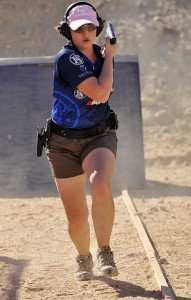 Julie: Which one? LOL! I think there were a couple in there, but Stage 1 was one of the worst. Uncharacteristic is kind. Folks, if you ever have the misfortune of watching it on video, it looked much worse than it probably was. At least, that’s what I tell myself. ; ) I knew I was behind in the standings and I took a chance on that stage. Not only did I just shoot it poorly, the plan probably was gutsy. On that stage there was a chance that if you opened a door before you shot a small plate at a lean you could save HUGE time. It was a really TOUGH shot though. I guess shooters from the first match discovered it wasn’t worth the risk, but since I wasn’t there for that I’ll blame my performance officially on the jet lag. ; ) In all seriousness, if I had connected it would have been brilliant, but for that to have happened stars would have had to align. You gamble in Vegas, right?
Julie: Which one? LOL! I think there were a couple in there, but Stage 1 was one of the worst. Uncharacteristic is kind. Folks, if you ever have the misfortune of watching it on video, it looked much worse than it probably was. At least, that’s what I tell myself. ; ) I knew I was behind in the standings and I took a chance on that stage. Not only did I just shoot it poorly, the plan probably was gutsy. On that stage there was a chance that if you opened a door before you shot a small plate at a lean you could save HUGE time. It was a really TOUGH shot though. I guess shooters from the first match discovered it wasn’t worth the risk, but since I wasn’t there for that I’ll blame my performance officially on the jet lag. ; ) In all seriousness, if I had connected it would have been brilliant, but for that to have happened stars would have had to align. You gamble in Vegas, right?
As far as tackling the set back, I have had lots of these in my career. It’s not the first and probably not the last. The only thing you can do in that situation is attack what’s next and keep the fire burning.
WoUSPSA: Great advice! In other sports, top contenders compete together. Do you feel that USPSA should require that established shooters and national champions shoot together or do you feel that competitors should always have the option to choose? What are the pros and cons of shooting with the ladies?
Julie: I can see both sides of the argument. We all pay the same entry fee so we should be afforded the same opportunity to shoot with who we wish. At the same time though, this is a national championship. Our World Shoot Team is in part decided from this event. A national title and a chance to represent the United States is at stake and that should be taken very seriously. If we ever want our sport to grow and become established like every other major sport, the contenders need to compete together for coverage and the same conditions for fairness. At the very least, these competitors need to shoot in squads that are next to each other and at the same time of day. I know I love the fact that I have the opportunity to compete with some of the best women shooters in the world. If I place, I work to make sure I put myself in a position so that media can cover it. It only helps increase exposure for the people and companies that support me. Without amazing support from my sponsors, especially Smith & Wesson I wouldn’t be able to compete at a national and world level.
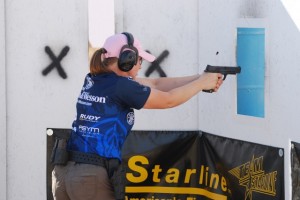 WoUSPSA: Why do you think the participation is low for women in some of the iron-sight divisions and what can we do to change that?
WoUSPSA: Why do you think the participation is low for women in some of the iron-sight divisions and what can we do to change that?
Julie: I think one of the reasons Open is so appealing is that it is viewed as a simple division to jump into. Starting a new shooter in Open can be easier because you can say, “when that red dot is where you want it, squeeze the trigger.” There are also FEWER reloads that allow new competitors to just shoot. Now, don’t get me wrong! To perform at the top of the game in Open there’s SO MUCH more to it, but for someone starting out or the occasional shooter that just likes to go to their local match, it can make a lot of sense.
Looking at the stats, there were 24 women in the Open Division at this year’s nationals. Combine all the iron sight divisions there were 29 women! I think the issue is that we are all spread out and so collectively the presence is strong. I think we’ve already made a huge step with Women of USPSA in building up the other divisions. Having a resource for female shooters and celebrating their success across all the divisions is a great start.
WoUSPSA: Here, here! Was this your last major match of the year or do you have more competitions on your schedule?
Julie: It was my last “serious” match. I have one more planned in December, but with snow already falling in Montana this year, hunting season and many other projects, I don’t expect to get a lot of training time in.
WoUSPSA: With the match season rather lengthy, how do you typically unwind when the year is done?
Julie: I never seem to stop going so I am always doing something that’s shooting sport related, but I feel this time of year I can breathe a little bit. I do have some big projects to tackle but the competition side of things can take a rest. What I love most about this time of year is hunting and actually having the time to cook. I’ll dig out all my food magazines and start roasting coffee beans. This is my favorite time of year and I think it’s important to reflect on everything and everyone to be thankful for. I am very fortunate to have a long list!
WoUSPSA: With game in the freezer and beans in the roaster, sounds like it will be a great off-season! Now, what are your long-term competitive shooting goals?
Julie: My shooting “bucket list” includes a number of things. I would like to win a title at the World Shoot. I REALLY want to shoot a 1920 in Bianchi. Making a US Olympic team in Sport Pistol would be so awesome. I want to shoot some Multi-Gun matches and definitely more shotgun. I LOVE shooting Sporting Clays with my Benelli! Oh… And there’s that 6th Division title. That’d be really nice.
WoUSPSA: That’s an awesome bucket list – we wish you the best with your goals! : ) Do you have any special talents or skills that you would like to share with us?
Julie: Hmmm… I used to sing and was actually pretty decent at it in high school. My husband is a fan of my many cooking experiments or at least he is smart enough to say so. ; ) Oh, and oddly enough I so enjoy editing video and its what I refer to as my creative outlet.
WoUSPSA: Definitely a smart man, although your meals look pretty appetizing on your FB page! When you aren’t on the road or at the range, what’s one of your favorite activities to do when home?
Julie: I so look forward to the time I spend with my husband and daughter. I really love being a mom so all the things that involve that are my favorites.
WoUSPSA: What advice would you give to any new shooters starting out?
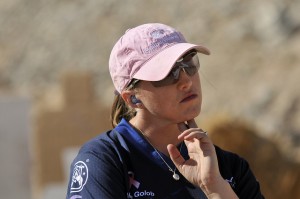 Julie: My advice would be to learn the rules of whatever shooting sport you plan to try. Make sure before you shoot your first match you are completely familiar with your firearm and how to shoot and handle it safely in competition. Next, spend a lot of time dryfiring the skills that you know you may encounter on the range, like in USPSA the draw and reloading are good skills to work on. Remember dry fire means NO AMMO around! After that try to learn as much as you can by watching your fellow competitors. Most of all though, have fun!
Julie: My advice would be to learn the rules of whatever shooting sport you plan to try. Make sure before you shoot your first match you are completely familiar with your firearm and how to shoot and handle it safely in competition. Next, spend a lot of time dryfiring the skills that you know you may encounter on the range, like in USPSA the draw and reloading are good skills to work on. Remember dry fire means NO AMMO around! After that try to learn as much as you can by watching your fellow competitors. Most of all though, have fun!
WoUSPSA: Rules – very good point … and to stay energized, what is your snack and beverage of choice on the range?
Julie: I drink water. Lots and lots of it! I am also a huge fan of 100% juice/vegetable drinks, bananas and fruit/nut bars. I eat and drink constantly throughout a match to keep my energy level up.
WoUSPSA: Do you lift weights or do grip strengthening exercises to specifically build your muscles used in shooting? What other kinds of physical training do you do?
Julie: I CrossFit (www.crossfit.com) which incorporates so many things that help me perform well in competition from weight training to cardio based work outs to some that incorporate both. I also do yoga and run as well. Working out helps me feel fit and energized when competing.
WoUSPSA: As a competitor that’s shot USPSA for more than 15+ years and someone who is actively involved in the promotion of the shooting sports, what direction would you like to see the future USPSA take?
 Julie: Next year it will be 20 years of competing, and on top of that I have been involved with USPSA working as an RO several years before that. I think it’s wonderful how USPSA has grown especially in the past few years. With the internet and shows on cable TV we have so much more access to shooting than ever before. I’d love to see our sport continue to prosper and become even more organized.
Julie: Next year it will be 20 years of competing, and on top of that I have been involved with USPSA working as an RO several years before that. I think it’s wonderful how USPSA has grown especially in the past few years. With the internet and shows on cable TV we have so much more access to shooting than ever before. I’d love to see our sport continue to prosper and become even more organized.
I’d love to see USPSA incorporate a historical archive on the website – a virtual museum if you will. Our sport is young, but at the same time we need to make sure we capture the stories, stats, champions, evolution of guns, and divisions – the roots of USPSA! An accessible history helps establish us as a serious organization.
There are also so many things we can learn from even mainstream sporting competitions that I would love to see applied to our organization. The more we can offer, the easier it is to spread the word and get people interested in joining us on the range.
WoUSPSA: So many great thoughts! And lastly, how did you and Simon celebrate your awesome finish at the USPSA Production Nationals?
Julie: We didn’t really have a chance to with our daughter being sick. It was just great to be home after such an intense travel schedule. That was a celebration in itself.
WoUSPSA: … there’s no place like home. Julie – thanks so much for taking a moment to anwer our questions. Congratulations again on your 2nd Place Production finish!
Now, let’s watch Julie blaze through a few stages at the Production Nationals.



 MidwayUSA
MidwayUSA Ruger Firearms
Ruger Firearms SCCY Firearms
SCCY Firearms Streamlight
Streamlight Action Targets
Action Targets Gunsite Academy
Gunsite Academy
You must be logged in to post a comment Login